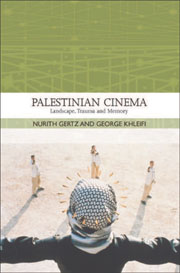Book contents
- Frontmatter
- Contents
- TRADITIONS IN WORLD CINEMA
- Dedication
- Introduction
- 1 A Chronicle of Palestinian Cinema
- 2 From Bleeding Memories to Fertile Memories
- 3 About Place and Time: The Films of Michel Khleifi
- 4 Without Place, Without Time: The Films of Rashid Masharawi
- 5 The House and its Destruction: The Films of Ali Nassar
- 6 A Dead-End: Roadblock Movies
- 7 Between Exile and Homeland: The Films of Elia Suleiman
- Conclusion
- Epilogue
- Bibliography
- Filmography
- Index
7 - Between Exile and Homeland: The Films of Elia Suleiman
Published online by Cambridge University Press: 05 August 2013
- Frontmatter
- Contents
- TRADITIONS IN WORLD CINEMA
- Dedication
- Introduction
- 1 A Chronicle of Palestinian Cinema
- 2 From Bleeding Memories to Fertile Memories
- 3 About Place and Time: The Films of Michel Khleifi
- 4 Without Place, Without Time: The Films of Rashid Masharawi
- 5 The House and its Destruction: The Films of Ali Nassar
- 6 A Dead-End: Roadblock Movies
- 7 Between Exile and Homeland: The Films of Elia Suleiman
- Conclusion
- Epilogue
- Bibliography
- Filmography
- Index
Summary
A comparison of Suleiman's two feature films, Chronicle of a Disappearance (1996) and Divine Intervention (2002), lends itself to a comprehensive review of what had transpired in Palestinian society in general and in its cinema in particular during the period between the signing of the Oslo peace accords and the Second Intifada, from “the calm before the storm,” as Suleiman calls it, to “total devastation and disintegration” (Erickson, 2003). The two films revolve around similar episodes. In both, some of the scenes take place in the home of Suleiman's parents in Nazareth and others in Jerusalem; in both the director adopts a comical stance toward the ordinary day-to-day friction between the Arabs of Nazareth and toward the Jewish-Israeli violence in Jerusalem; and both culminate in a fantasy of revenge against the Israelis.
The differences between ostensibly similar films highlight the historical, ideo – logical, and cinematic developments that took place in the short time that elapsed between the making of the first film and the production of the second. In the earlier film, we encounter diverse locations: the house of Suleiman's parents in Nazareth, the director's home in Jerusalem, and the width and breadth of the various vistas unfolding in the course of his journeys across the country. Although these spaces are crowded and threatened, it seems possible to remain in them and to conduct one's daily life, albeit one charged with violence.
- Type
- Chapter
- Information
- Palestinian CinemaLandscape, Trauma and Memory, pp. 171 - 189Publisher: Edinburgh University PressPrint publication year: 2008



